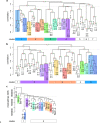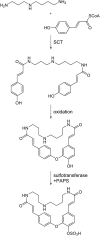Natural variation of root exudates in Arabidopsis thaliana-linking metabolomic and genomic data
- PMID: 27363486
- PMCID: PMC4929559
- DOI: 10.1038/srep29033
Natural variation of root exudates in Arabidopsis thaliana-linking metabolomic and genomic data
Abstract
Many metabolomics studies focus on aboveground parts of the plant, while metabolism within roots and the chemical composition of the rhizosphere, as influenced by exudation, are not deeply investigated. In this study, we analysed exudate metabolic patterns of Arabidopsis thaliana and their variation in genetically diverse accessions. For this project, we used the 19 parental accessions of the Arabidopsis MAGIC collection. Plants were grown in a hydroponic system, their exudates were harvested before bolting and subjected to UPLC/ESI-QTOF-MS analysis. Metabolite profiles were analysed together with the genome sequence information. Our study uncovered distinct metabolite profiles for root exudates of the 19 accessions. Hierarchical clustering revealed similarities in the exudate metabolite profiles, which were partly reflected by the genetic distances. An association of metabolite absence with nonsense mutations was detected for the biosynthetic pathways of an indolic glucosinolate hydrolysis product, a hydroxycinnamic acid amine and a flavonoid triglycoside. Consequently, a direct link between metabolic phenotype and genotype was detected without using segregating populations. Moreover, genomics can help to identify biosynthetic enzymes in metabolomics experiments. Our study elucidates the chemical composition of the rhizosphere and its natural variation in A. thaliana, which is important for the attraction and shaping of microbial communities.
Figures






Similar articles
-
Piriformospora indica Stimulates Root Metabolism of Arabidopsis thaliana.Int J Mol Sci. 2016 Jul 8;17(7):1091. doi: 10.3390/ijms17071091. Int J Mol Sci. 2016. PMID: 27399695 Free PMC article.
-
Plant-to-Plant Variability in Root Metabolite Profiles of 19 Arabidopsis thaliana Accessions Is Substance-Class-Dependent.Int J Mol Sci. 2016 Sep 16;17(9):1565. doi: 10.3390/ijms17091565. Int J Mol Sci. 2016. PMID: 27649165 Free PMC article.
-
Non-targeted profiling of semi-polar metabolites in Arabidopsis root exudates uncovers a role for coumarin secretion and lignification during the local response to phosphate limitation.J Exp Bot. 2016 Mar;67(5):1421-32. doi: 10.1093/jxb/erv539. Epub 2015 Dec 17. J Exp Bot. 2016. PMID: 26685189 Free PMC article.
-
Metabolomics in the Rhizosphere: Tapping into Belowground Chemical Communication.Trends Plant Sci. 2016 Mar;21(3):256-265. doi: 10.1016/j.tplants.2016.01.008. Epub 2016 Jan 30. Trends Plant Sci. 2016. PMID: 26832948 Review.
-
Root Exudation of Specialized Molecules for Plant-Environment Interaction.Chimia (Aarau). 2022 Nov 30;76(11):922-927. doi: 10.2533/chimia.2022.922. Chimia (Aarau). 2022. PMID: 38069787 Review.
Cited by
-
Tapping into Plant-Microbiome Interactions through the Lens of Multi-Omics Techniques.Cells. 2022 Oct 17;11(20):3254. doi: 10.3390/cells11203254. Cells. 2022. PMID: 36291121 Free PMC article. Review.
-
The rhizosphere microbiome: Plant-microbial interactions for resource acquisition.J Appl Microbiol. 2022 Nov 1;133(5):2864-2876. doi: 10.1111/jam.15686. J Appl Microbiol. 2022. PMID: 36648151 Free PMC article. Review.
-
Potassium Chloroaurate-Mediated In Vitro Synthesis of Gold Nanoparticles Improved Root Growth by Crosstalk with Sucrose and Nutrient-Dependent Auxin Homeostasis in Arabidopsis thaliana.Nanomaterials (Basel). 2022 Jun 18;12(12):2099. doi: 10.3390/nano12122099. Nanomaterials (Basel). 2022. PMID: 35745438 Free PMC article.
-
The dynamic response of the Arabidopsis root metabolome to auxin and ethylene is not predicted by changes in the transcriptome.Sci Rep. 2020 Jan 20;10(1):679. doi: 10.1038/s41598-019-57161-9. Sci Rep. 2020. PMID: 31959762 Free PMC article.
-
Disruption of Firmicutes and Actinobacteria abundance in tomato rhizosphere causes the incidence of bacterial wilt disease.ISME J. 2021 Jan;15(1):330-347. doi: 10.1038/s41396-020-00785-x. Epub 2020 Oct 7. ISME J. 2021. PMID: 33028974 Free PMC article.
References
-
- Mithen R., Clarke J. H., Lister C. & Dean C. Genetics of aliphatic glucosinolates. III. Side chain structure of aliphatic glucosinolates in Arabidopsis thaliana. Heredity (Edinb). 74, 210–215 (1995).
-
- Mithen R. & Campos H. Genetic variation of aliphatic glucosinolates in Arabidopsis thaliana and prospects for map based gene cloning. Entomologica Experimentalis et Applicanta. 53, 202–205 (1996).
-
- Magrath R. et al.. Genetics of aliphatic glucosinolates. I. Side chain elongation in Brassica napus and Arabidopsis thaliana. Heredity (Edinb). 72, 290–299 (1994).
Publication types
MeSH terms
Substances
LinkOut - more resources
Full Text Sources
Other Literature Sources
Molecular Biology Databases

